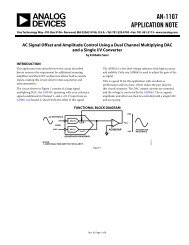Jean-Louis Malinge - EEWeb
Jean-Louis Malinge - EEWeb
Jean-Louis Malinge - EEWeb
Create successful ePaper yourself
Turn your PDF publications into a flip-book with our unique Google optimized e-Paper software.
TECHNICAL Roger Stout ARTICLE<br />
Back in the days when most electronics components<br />
were packaged in metal cans (or manufactured as axial<br />
leaded devices with equipment housings generally<br />
spacious and un-crowded), matters of device level<br />
thermal management were relatively straightforward<br />
for design engineers. Sadly, thermal management has<br />
become much more of a challenge nowadays – both to<br />
understand and to tackle; with multi-pin plastic packaged<br />
devices in ever-shrinking formats being incorporated<br />
into high component density portable electronics with<br />
considerable pressure being placed on available space<br />
and overall power efficiency.<br />
The following article details some of the key areas of<br />
concern in regard to device level thermal management<br />
in modern electronic products, with explanations of the<br />
fundamental theory behind it as well as some practical<br />
considerations.<br />
First principles<br />
Senior Research Scientist<br />
Thermal<br />
Basics of<br />
Complex<br />
Devices<br />
As we all know from basic thermodynamics, heat energy<br />
will flow from a higher temperature region to a lower<br />
temperature region (this being done through either<br />
conduction, convection, radiation or often a combination<br />
of these). Furthermore, the bigger the temperature<br />
difference witnessed, the greater the flow of heat will be.<br />
Historically, for discrete devices, the ‘junction’ referred to<br />
in the term junction temperature (TJ) was the PN junction<br />
of the device. Though this is true for basic rectifiers,<br />
bipolar transistors, etc, the junction now generally refers<br />
to the hottest point within the device. As we move towards<br />
more complex device constructions where different<br />
parts of the silicon have different functions at different<br />
times, locating the precise position of this point can be<br />
very difficult.<br />
A common misconception often held by engineers is that<br />
a device’s thermal resistance is an intrinsic property of<br />
the package in which it is enclosed. Among the reasons<br />
why this does not hold true is the fact that there is no<br />
isothermal surface, making it impossible to define a<br />
‘case’ temperature. Though the metal can devices of the<br />
past had a relatively good approximation of an isothermal<br />
surface, modern plastic packages tend to exhibit quite<br />
large gradients. Furthermore, in modern package types<br />
<strong>EEWeb</strong> | Electrical Engineering Community Visit www.eeweb.com 17<br />
TECHNICAL ARTICLE















